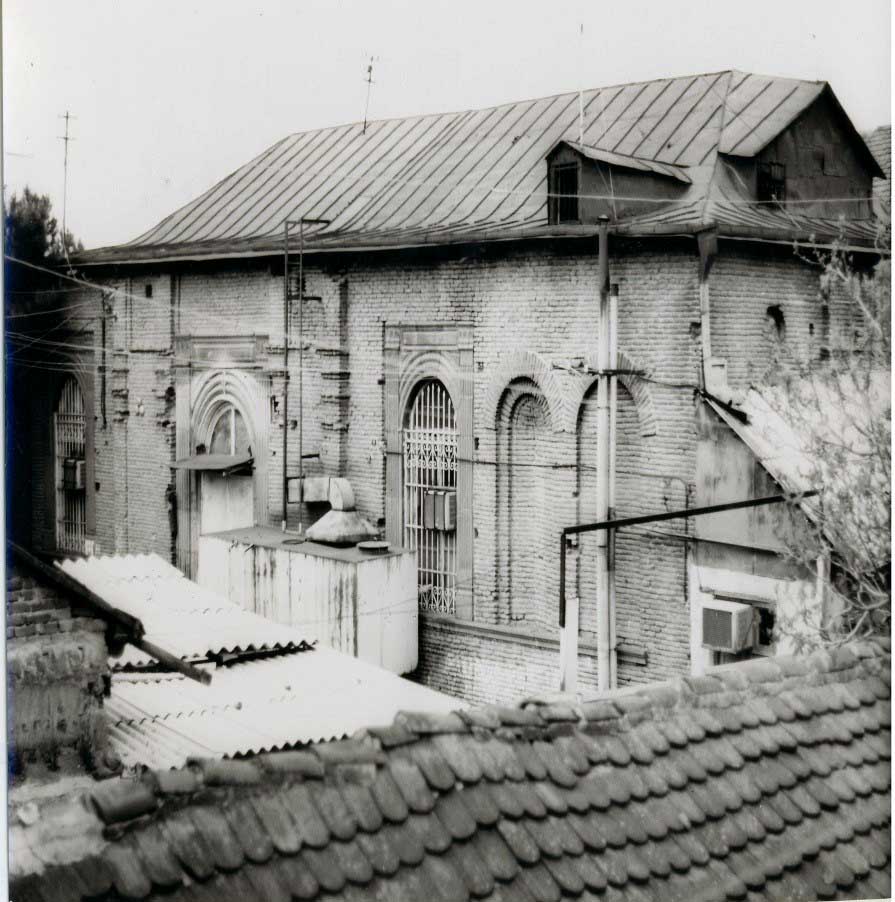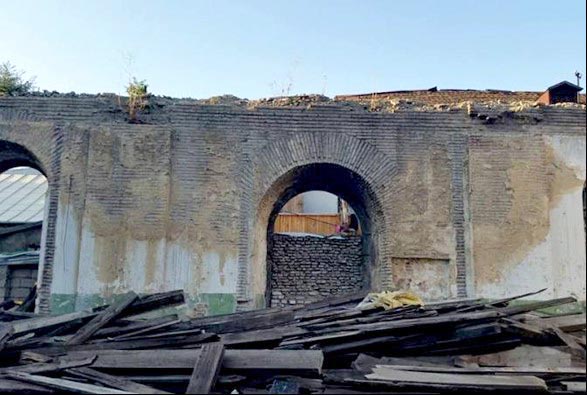YEREVANTSOTS ST. MINAS CHURCH
THE CHURCH WAS ESTABLISHED IN 1790 AND ON JANUARY 2, 1883, THE NEW YEREVANTSOTS ST. MINAS CHURCH WAS BUILT ON THE PLACE OF THE OLD CHURCH. IT IS PARTIALLY DESTROYED.
Establishment and reconstruction: St. Minas Church is located at 13 Gelati (formerly Iorskaya Street) in Tbilisi [1]. Egn. Ioseliani, a Georgian researcher, reported valuable information about the construction of the church, proving that it is an Armenian church [2]. According to L. Melikset-Bek, the church was founded with funds from people living in Avlabari and was named after Saint Minas The Witness [3]. Both Armenian and Georgian researchers consider 1790 as the year of the church's foundation.
In the 19th and 20th centuries, St. Minas church underwent repair and reconstruction several times. The first renovation was carried out in 1811[4]. It was largely rebuilt in the 1880s. The new church replicated the structure of the old church, which was made of brick and covered with wood[5]. The completely rebuilt church was consecrated on January 2, 1883 [6]. At the beginning of the 20th century, efforts were made to advance the construction of the church wall and the adjacent two-story building[7].
Architecture: St. Minas church is a three-naved basilica typical of late medieval Armenian architecture with two pairs of pillars, rectangular sacristies on both sides, and a semicircular apse [8]. The church extends the entire length of the street. The spacious hall was covered with a wooden arch, lined with double-sided tin sheets. Currently, the wooden cover is completely collapsed. The east and west facades have no pediments and the whole building resembles a secular building. The interior of the church was quite large. Apart from the eastern side, it had entrances from the other three sides, which were quite wide and high. The facades are strictly symmetrical. On the east side of the church, currently, there is a long storeroom that covers the east windows. The beginning of a window arch can be seen above the attached structure. A warehouse was also built in the western part [9].
Clergy and churchwardens: In the 20s of the 19th century, Rev. Father Ter-Hovhannes Astvatsaturyan was a priest in St. Minas church [10].  Among church members of the Brotherhood were Rev. Fathers Zakaria Ter-Davtyan[11], Lazaros Hovsepyants[12], Gevorg Ter-Hovhannisyan[13], Aristakes Benkliants[14].
Among church members of the Brotherhood were Rev. Fathers Zakaria Ter-Davtyan[11], Lazaros Hovsepyants[12], Gevorg Ter-Hovhannisyan[13], Aristakes Benkliants[14].
In 1817 Mr. Grigor is mentioned as churchwarden at St. Minas church. His account book has also been preserved[15]. Nazar Apyants[16], Hovhannes Avagyan[17], Poghos Katanyants[18], and Sedrak Barseghyan[19] were among the churchwardens at the beginning of the 20th century.
Church properties: In the 1838 church property archival documents of the Armenian Apostolic Church in Georgia and the Imeretian Diocese, there is a mention of the movable and immovable property of St. Minas church. Apart from various church items, it also had rooms available for rent and lands adjacent to the church[20]. At the beginning of the 20th century, the church owned both the two shops on the street called Shirazkhana, as well as a shop near the school building in its yard[21]. It is also known that Davit Izmiryants bequeathed some estates to the church[22]. Besides Izmiryants, Ghazar Apyants also donated to the church. Particularly, in 1900, he donated to the church a one-story building with an adjacent yard, worth 1450 rubles, located in the 7th district of Avlabari. It occupied about 54.23 fathoms of land [23].
School: Archival documents regarding the opening of the parish school attached to St. Minas church provide information from the 60s of the 19th century. Specifically, in1860-1862, new rooms were built in the narthex of St. Minas church, one of which was used for educational purposes[24]. Later, in 1872, under the auspices of Archbishop Makar, a branch of the Mariamian School for females was opened next to St. Minas church[25]. In the late 1870s, the famous Izmirian school was also opened next to the church[26].
The church in the Soviet and post-Soviet period: Anti-ecclesiastical and anti-religious policies, persecutions, and repressions of Bolsheviks towards the church were clearly manifested in the 1920s and 1930s. In 1924, by the decision of the Central Executive Committee of Tiflis, St. Minas church was allocated to the Avlabari regional committee in order to open a district club there [27]. Later, the church building was used as a sewing workshop, and since the mid-1990s it has been abandoned.
On October 1, 2007, St. Minas church was given the status of a historical monument, but it did not contribute to the preservation of the church. In this regard, the Armenian Diocese in Georgia has sent numerous letters to the relevant authorities, but no changes have been made. In 2009, and then in 2011, 2012, and 2015 as well the Armenian Diocese in Georgia presented the state of St. Minas and other Armenian churches to the relevant authorities of Georgia with many warning letters, but there was no change. On September 19, 2014, the roof of the church collapsed due to rain, and instead of repairing it, the municipality completely removed the roof from the church[28]. It is not fenced, and in recent years there have been disputes over the church grounds between residents living next to the church. The area adjacent to the church was privatized by a private person. Private buildings have started to be built on the territory of the church.
[1] Avlabari, near the operating Etchmiatsnetsots church
[2] P. Muradyan, Armenian churches of Old Tiflis, St. Etchmiadzin, 2009, p. 233:
[3] L. Melikset-Bek, Georgian sources about Armenia and the Armenians, Vol. 3, Yerevan, 1955, p. 268:
[4] NAA, ֆ. 332, ց. 1, գ. 102, թ. 16-ի շրջ.:
[5] “Meghu Hayastani” weekly newspaper, 1880, N 49, p. 4:
[6] “Meghu Hayastani” weekly newspaper, 1883, N 1, p. 4:
[7] NAA, ֆ. 53, ց. 1, գ. 2464, թ. 10:
[8] M. Hasratyan, The architecture of the Armenian churches of Tbilisi, “Etchmiadzin”, 2009 (6), p. 74:
[9] L. Melikset-Bek, 1923: Materials for the History of Tpilisi and "Somkhit" Antiquities, Our Science, 1923, 1, Tpilisi, p. 92: O. Tgemalashvili., 1967, Tbilisi (guide):
[10] Nerses Ashtaraketsi’s archive, paper 166, doc. 874:
[11] NAA, ֆ. 53, ց. 1, գ. 2614, թ. 63:
[12] NAA, ֆ. 53, ց. 1, գ. 2273, թ. 238.:
[13] NAA, ֆ. 53, ց. 2, գ. 2375, թ. 1-ի շրջ.-2:
[14] NAA, ֆ. 53, ց. 2, գ. 2380, թ. 1-ի շրջ.-2:
[15] Catholicosate archives, paper 31, doc. 198:
[16] NAA, ֆ. 53, ց. 1, գ. 1050, թ. 2:
[17] NAA, ֆ. 53, ց. 1, գ. 2464, թ. 10:
[18] NAA, ֆ. 53, ց. 1, գ. 3099, թ. 21:
[19] NAA, ֆ. 53, ց. 1, գ. 3099, թ. 37:
[20] NAA, ֆ. 56, ց. 6, գ. 39, թթ. 78-ի շրջ.-80:
[21] NAA, ֆ. 53, ց. 1, գ. 3099, թ. 60:
[22] NAA, ֆ. 53, ց. 1, գ. 3099, թ. 17, 39:
[23] NAA, ֆ. 56, ց. 4, գ. 3861, թ. 1; 8:
[24] NAA, ֆ. 53, ց. 1, գ. 2252, թթ. 115-116; ֆ. 56, ց. 5, գ. 55, թթ. 411-412 և շրջ.:
[25] "Norashen", in the same place.
[26] NAA, ֆ. 53, ց. 1, գ. 2273, թ. 71-ի շրջ.:
[27] NAA, ֆ. 409, ց. 1, գ. 3135, թ. 3 և շրջ.:
[28] Press Department of the Armenian Diocese in Georgia
 Հայերեն
Հայերեն  ქართული
ქართული  English
English  Русский
Русский 


